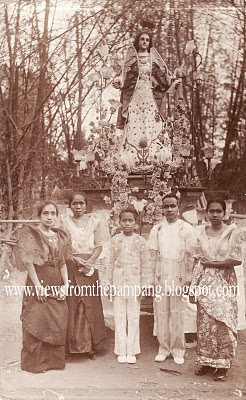 FOLLOW YOUR FAITH. A famil in Centra Luzon rolls out its carroza with the heirloom image of Sta.Maria Jacobe, one of the women who visited the tomb of Christ, for the annual Holy Week procession. Ca. mid 1920s.
FOLLOW YOUR FAITH. A famil in Centra Luzon rolls out its carroza with the heirloom image of Sta.Maria Jacobe, one of the women who visited the tomb of Christ, for the annual Holy Week procession. Ca. mid 1920s.The season of Lent officially begins on Ash Wednesday, a day of marked with abstinence, personal sacrifice and austerity. But somehow, or so it seems, during Semana Santa (Holy Week), all thoughts of economics and abject simplicity vanish as a people’s religious fervor find release in the opulent and dramatic prusisyons (or limbun) that feature a long parade of life-size heirloom santos and complex tableaus, visualizing the events of the Passion. Introduced to the Islands by our Spanish colonizers, holy processions have evolved from a simple act of veneration to complex showcases of ritual pageantry.
In terms of religious revelry, Pampanga offers some of the country’s more unique expressions of faith during Maleldo (Holy Week). Other than the display of blood and gore by magdarames (flagellants) culminating in actual and shocking crucifixions, the prusisyons (or limbuns )of old Kapampangan towns provide stunning spectacles featuring antique sculpted imagenes dressed in gold-embroidered vestments, crowned with gem-encrusted halos and diadems, festooned with dazzling lights and arrayed on flower-bedecked carrozas of silver.
Indeed, the list of the most treasured and remarkable santos that go on “limbun” during Maleldo is long. In Arayat, the age-old Manalangin (Agony in the Garden) tableau of the Medina family shows a small lithe angel with silver wings attired in short pants. In Guagua, which reputedly has the best processional line up, the ivory Dolorosa of the Limsons and the Sto. Entierro—figure of the dead Christ in its own stately funeral bier---are the images to watch. Nearby Sta. Rita boasts of an ancient calandra (owned by the Manalangs) still complete with its original and intricate silver fittings, lit by delicate antique tulip-shaped glass globes.
Angeles has its own Apung Mamacalulu (Sto. Entierro, owned by the Dayrits) which figured in a controversial 1929 Good Friday procession that ended in its kidnapping . It took the Supreme Court to resolve the issue of its ownership. While Apalit has an exquisite Magdalena and Mabalacat’s jewel is a beautiful Veronica, Lubao has a San Pedro that rides a boat-shaped carroza. Fernandinos in the capital city meanwhile, take pride in the images of the Sorrowful Virgin and Peter, handiworks of the country’s foremost santero, Maximo Vicente and the 19th c. Misericodia Christ image of the Rodriguezes.
Equally arresting are other quaint processional rituals such as that practiced in Bacolor. On Good Friday, handpicked representatives of prominent families take to the processional route dressed in black hoods while bearing the different symbols of the Passion—ladder, spear, whip, robe, etc.—on poles. This practice, called “paso”—has been a tradition in this town for as long as one can remember.
Other Pampanga towns like Betis and Mabalacat, also stage their own “dakit cordero” on Holy Thursday, where a “lamb” , handmade from cotton or from edible ingredients like yam, is brought to the church in a short procession, prefacing the eucharistic meal.
There are no signs that the Kapampangan’s interest in “limbuns” is waning, as evidenced by the growing number of images and the longer processions that take to the town streets each year. Even not-too-popular figures such as Sta. Maria Jacobe, Nicodemus, Jose de Arimatea are being added to the line-up. Blame it on his fierce and unflagging devotion to his God. Or his penchant for divine excess. One can also point to the pool of talented Kapampangan artisans who wield their chisels and paint brushes who create with ease and skill, these precious objects of veneration. Whatever the reason, we, Kapampangans, can continue our walks of faith content in the thought that our revered religious traditions will live on.








No comments:
Post a Comment